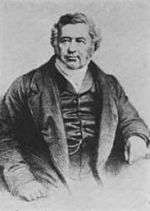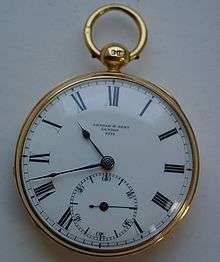Edward John Dent
Edward John Dent (1790–1853) was a famous English watchmaker noted for his highly accurate clocks and marine chronometers.
Edward John Dent | |
|---|---|
 Edward John Dent | |
| Born | 19 August 1790 London |
| Died | 8 March 1853 London |
| Nationality | United Kingdom |
| Occupation | Engineer |
| Engineering career | |
| Discipline | Clockmaker and watchmaker |
| Significant advance | accurate clocks and marine chronometers |
He founded the Dent company.
Early years
Edward John Dent, son of John and Elizabeth Dent, was born in London on 19 August 1790. He was baptised on 18 October 1790, at St. Clement Danes Church in the Strand. Edward had a younger brother, William (born 11 February 1792). The boys' mother, Elizabeth, died while they were still young – she was buried on 16 May 1793.
Interest in watchmaking
At the age of 14, Dent became apprenticed to his grandfather, John Wright Dent, a tallow chandler. Under the terms of the indenture – dated 20 August 1804 – John Wright Dent was expected to find suitable lodgings for his apprentice. Fortunately, Edward John Dent's cousin, Richard Rippon, was willing to have him. Rippon was an expert watchmaker and Dent became fascinated by watchmaking and less interested in the business of making and selling candles. Indeed, Dent became so interested in the watchmaking craft that, on 13 February 1807, his grandfather agreed to transfer the remaining years of the seven-year apprenticeship as a tallow chandler to Edward Gaudin, Watchmaker.[1]
1814–1829: "The formative years"
In 1814, when Dent was just 24 years old, he was becoming well known as a watchmaker and clockmaker of some distinction: in this year he supplied a Standard Astronomical Clock for the Admiralty, and at least one pocket chronometer for the Colonial Office African Expedition. As early as 1814, Dent was making clocks and chronometers on his own account, but not in sufficient quantities to earn him a satisfactory livelihood.
During 1815–29, it is believed that Dent worked for a number of well known firms. One such firm was Callum Brothers of Castle Street, Long Acre. It is almost certain Richard Rippon had worked for them, and had introduced Dent to the firm.[2]
In 1826 Dent submitted two chronometers, Nos. 54 and 55, for trial at Greenwich. This must indicate that he had made at least 55 chronometers by 1826. His submitting chronometers for trial brought him to the notice of the authorities at Royal Observatory, Greenwich.[2] Indeed, in 1828 Dent was employed by Royal Observatory, Greenwich to examine and repair chronometers. His charges for repairing chronometers were as high as 25 guineas – an apparently exorbitant cost, but one that was nevertheless accepted.[3]
In a letter to the Board of Ordnance, dated March, 1829, John Pond – at the time Astronomer Royal – described Dent as "among the best workmen of the present day."[3] Dent's reputation for precision eventually brought requests from the Admiralty and the East India Company. His reputation was given another boost when, in August, 1829, Dent Marine Chronometer No. 114 won the First Premium Award at the Seventh Annual Trial of Chronometers. Dent took full advantage of his win, mentioning it wherever possible in his advertisements.[4]
1830–1840: Arnold & Dent

In 1830, Dent learned of an opening available for a skilled craftsman in the firm of John Roger Arnold of 84 Strand. But instead of becoming an employee of the firm, Dent became a partner. The partnership was signed on 30 September 1830. The partnership suited both men. Arnold, who was 61 at the time, could still have a say in the running of the business, and could now have time to spend on his hobby, which was inventing new mechanisms of all kinds. Dent, aged 40, was in a position to advertise his ability as a technician and to use his great business sense to put his firm on to a really sound footing.[5]
To draw attention to the firm, now known as 'Arnold & Dent', Dent arranged advertisements in The Nautical Magazine. Dent also sent the results of their experiments to the editor so that they would be published in this magazine. One of the first notices – published in May, 1832 – read:
Messrs. Arnold and Dent have just completed another of those beautiful specimens of art, in the shape of a pocket chronometer, showing at once both mean and sidereal time. This is the fourth of these machines that has been made.
In an article entitled Hints on Chronometers appearing in Nautical Magazine and dated February 1833, Dent reveals that chronometer No. 633 was sent with 21 other chronometers to Captain FitzRoy on board HMS Beagle in 1831. In fact, several of these chronometers were by Arnold and Dent.[6] A passenger on this, The Second Voyage of HMS Beagle, was Charles Darwin. Indeed, Darwin's observations on that voyage led to the publication of his On the Origin of Species.
The last two years of the partnership between Arnold & Dent were unhappy ones. Dent's hopes of taking over the business were frustrated, and as a result, he became exasperated. Perhaps understandable when Dent possessed an almost fanatical determination to become the best chronometer maker in the world.[7]
And so on 30 September 1840, the partnership of Arnold and Dent came to an end.[8]
Post 1840
On 1 October 1840, the firm, known as E. J. Dent, London began its existence at 82 Strand.
On 21 March 1842, Dent applied for a Patent, to be entitled "Certain Improvements in Chronometers and other Timekeepers". This Patent covered various designs of compensation balance and the invention of a Remontoire for use in Marine chronometers.
In January 1843, Dent opened his second premises, at 33 Cockspur Street, just off Trafalgar Square. The shop displayed timepieces made by Breguet – whom Dent had met during his time with John Roger Arnold – as well the owner's creations.
In March 1843 production and sale of Dent's Dipleidoscope started (made to J. Bloxam's patent 9793 of 1843), and was to continue for some 25 years.
On 1 July 1843, Edward John Dent married Elizabeth Rippon – widowed when Richard Rippon died in 1835. Dent gained two stepsons (Frederick William and Richard Edward) and two-stepdaughters (Mary Elizabeth and Amelia Lydia Sophia).
Dent won the esteem of Sir George Airy, the Astronomer Royal, who recommended him as the maker of a large clock for the tower of the new Royal Exchange. Dent's tender was accepted and was announced in the ‘’Herald’’ on 20 August 1843:
NEW ROYAL EXCHANGE
At the east end there is to be a Tower, one hundred and forty feet high, containing the Clock and Chimes which latter characteristic is to be revived. This Clock is to be the best specimen that can be produced of modern skill in clock-making, and is intended to furhish the Merchants and Captains with the most accurate record of time in the City of London. It is to be made by Mr. Dent, the Clock and Chronometer Maker, under the direction of the Astronomer Royal, Professor Airy. The Peal of Bells will consist of nine Bells. The tenor will weight one ton, and the others in proportion. These Bells are now being cast by Mr. Mears, who cast the Monster Bell for Canada.
Dent established a workshop in Somerset Wharf, Strand, to produce this excellent timepiece, which was installed in 1844.
In 1852 Dent won the commission to make the great clock—now popularly called Big Ben—for the Houses of Parliament at Westminster, but he died before completing the project. Edward John Dent died on 8 March 1853, at the age of 62 and his adopted son completed the Great Clock.

The Dent company
Frederick Rippon Dent finished Big Ben in 1854. Dent's stepsons, Frederick and Richard, took his name and succeeded to his business and eventually became E.Dent & Co Ltd which ceased to trade in 1966.[9]
References
| Wikisource has the text of the 1885–1900 Dictionary of National Biography's article about Dent, Edward John. |
- Mercer, Vaudrey (1977). The Life and Letters of Edward John Dent, Chronometer Maker and some account of his Successors, p.15, The Antiquarian Horological Society. ISBN 0-901180-16-5.
- Mercer, Vaudrey (1977). The Life and Letters of Edward John Dent, Chronometer Maker and some account of his Successors, p.17, The Antiquarian Horological Society. ISBN 0-901180-16-5.
- Mercer, Vaudrey (1977). The Life and Letters of Edward John Dent, Chronometer Maker and some account of his Successors, p.18, The Antiquarian Horological Society. ISBN 0-901180-16-5.
- Mercer, Vaudrey (1977). The Life and Letters of Edward John Dent, Chronometer Maker and some account of his Successors, p.19, The Antiquarian Horological Society. ISBN 0-901180-16-5.
- Mercer, Vaudrey (1977). The Life and Letters of Edward John Dent, Chronometer Maker and some account of his Successors, p.26, The Antiquarian Horological Society. ISBN 0-901180-16-5.
- Fitz-Roy, Robert; King, Phillip Parker Narrative of the Surveying Voyages of His Majesty's Ships Adventure and Beagle, Between the Years 1826 and 1836, "Remarks on the chronometrical observations", Appendix to Volume 2, p.325, London: Henry Colburn, 1839.
- Mercer, Vaudrey (1977). The Life and Letters of Edward John Dent, Chronometer Maker and some account of his Successors, p.102, The Antiquarian Horological Society. ISBN 0-901180-16-5.
- Mercer, Vaudrey (1977). The Life and Letters of Edward John Dent, Chronometer Maker and some account of his Successors, p.101, The Antiquarian Horological Society. ISBN 0-901180-16-5.
- "Guildhall Library Manuscripts Section: General Guide" Institute of Historical Research, University of London, retrieved and archived 27 October 2011.